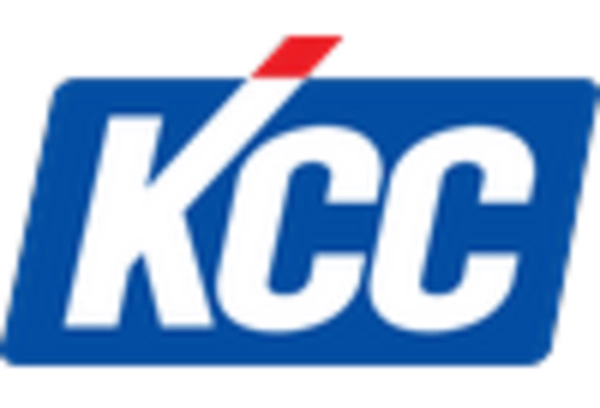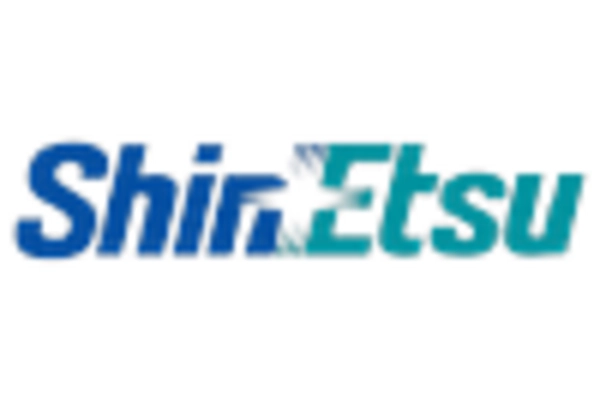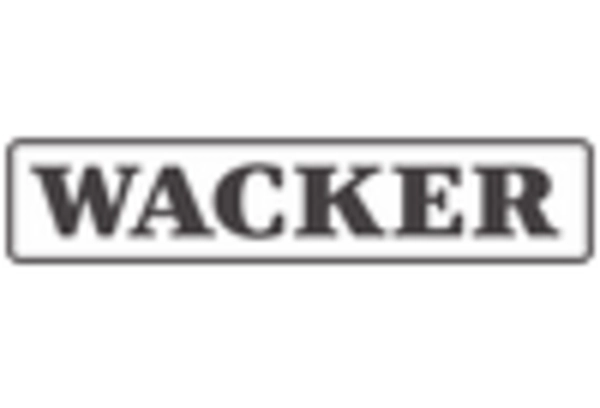-
Executive Summary
-
Market Introduction
-
Market Definition
-
Scope of the Study
-
Assumptions
-
& Limitations
-
Market Structure
-
Key Takeaways
-
Market Insights
-
Research Methodology
-
Research Process
-
Primary Research
-
Secondary Research
-
Market Size Estimation
-
Forecast Model
-
Market Dynamics
-
Introduction
-
Drivers
-
Restraints
-
Opportunities
-
Challenges
-
Trends
-
Market
-
Factor Analysis
-
Supply Chain Analysis
-
Raw Material Suppliers
-
Manufacturers/Producers
-
Distributors/Retailers/Wholesalers/E-Commerce Merchants
-
Power of Buyers
-
Bargaining Power of Suppliers
-
Threat of Substitutes
-
Intensity of Rivalry
-
Pricing Overview (USD/Ton)
-
Impact of COVID-19 on the Organosilicon Polymers (Polysiloxane) Market
-
EndUsers
-
Porter’s Five Forces Analysis
- Threat of New Entrants
- Bargaining
-
Global Organosilicon
-
Polymers (Polysiloxane) Market,by Product Type
-
Introduction
-
Silicone Oil
- Market Estimates & Forecast, 2019–2028
- Market Estimates
-
& Forecast, by Region, 2019–2028
-
Silicone Rubber
- Market Estimates & Forecast, 2019–2028
- Market Estimates
-
& Forecast, by Region, 2019–2028
-
Silicone Resin
- Market Estimates & Forecast, 2019–2028
- Market Estimates
-
& Forecast, by Region, 2019–2028
-
Silicone Emulsion
- Market Estimates & Forecast, 2019–2028
- Market Estimates
-
& Forecast, by Region, 2019–2028
-
Global Organosilicon Polymers (Polysiloxane) Market,by
-
Application
-
Introduction
-
Coatings
-
Market Estimates & Forecast, 2019–2028
-
8.2.2Market Estimates & Forecast, by Region, 2019–2028
-
Elastomers
- Market Estimates
-
& Forecast, 2019–2028
-
8.3.2Market
-
Estimates & Forecast, by Region, 2019–2028
-
Foams
-
Market Estimates & Forecast, 2019–2028
-
8.4.2Market Estimates & Forecast, by Region, 2019–2028
-
Adhesives & Sealants
- Market Estimates
-
& Forecast, 2019–2028
-
Market Estimates & Forecast, by Region, 2019–2028
-
Others
- Market Estimates & Forecast, by Region, 2019–2028
-
Market Estimates & Forecast, 2019–2028
-
Global Organosilicon
-
Polymers (Polysiloxane) Market, by Region
-
Introduction
-
North America
- Market Estimates & Forecast, 2019–2028
- Market Estimates
- Market Estimates & Forecast, by Application,
- Canada
- Market Estimates & Forecast, by Product Type,
-
& Forecast, by Product Type, 2019–2028
-
US
-
Estimates & Forecast, 2019–2028
-
Type, 2019–2028
-
9.2.4.3Market
-
Estimates & Forecast, by Application, 2019–2028
-
& Forecast, by Product Type, 2019–2028
-
9.2.5.3Market Estimates & Forecast, by Application,
-
Europe
-
Market Estimates & Forecast, 2019–2028
-
Market Estimates & Forecast, by Application, 2019–2028
-
9.3.4.1Market Estimates & Forecast,
-
Germany
-
Market Estimates & Forecast, by Product Type, 2019–2028
-
9.3.4.3Market Estimates & Forecast,
-
by Application, 2019–2028
-
France
-
Market Estimates & Forecast, 2019–2028
-
Type, 2019–2028
-
9.3.5.3Market
-
Estimates & Forecast, by Application, 2019–2028
-
9.3.6.1Market
-
Estimates & Forecast, 2019–2028
-
9.3.6.2Market Estimates & Forecast, by Product
-
Type, 2019–2028
-
9.3.6.3Market
-
Estimates & Forecast, by Application, 2019–2028
-
Market Estimates & Forecast, 2019–2028
-
Type, 2019–2028
-
9.3.7.3Market
-
Estimates & Forecast, by Application, 2019–2028
-
Market Estimates & Forecast, 2019–2028
-
9.3.8.2Market Estimates & Forecast, by Product
-
Type, 2019–2028
-
9.3.8.3Market
-
Estimates & Forecast, by Application, 2019–2028
-
& Forecast, by Product Type, 2019–2028
-
9.3.9.3Market Estimates & Forecast, by Application,
-
Poland
-
Market Estimates & Forecast, 2019–2028
-
Type, 2019–2028
-
9.3.10.3Market
-
Estimates & Forecast, by Application, 2019–2028
-
& Forecast, by Product Type, 2019–2028
-
Asia-Pacific
-
Market Estimates & Forecast, 2019–2028
-
9.4.3Market
-
Estimates & Forecast, by Application, 2019–2028
-
Market Estimates & Forecast, 2019–2028
-
9.4.4.2Market Estimates & Forecast, by Product
-
Type, 2019–2028
-
9.4.4.3Market
-
Estimates & Forecast, by Application, 2019–2028
-
9.4.5.1Market
-
Estimates & Forecast, 2019–2028
-
9.4.5.2Market Estimates & Forecast, by Product
-
Type, 2019–2028
-
9.4.4.3Market
-
Estimates & Forecast, by Application, 2019–2028
-
Market Estimates & Forecast, 2019–2028
-
Type, 2019–2028
-
9.4.6.3Market
-
Estimates & Forecast, by Application, 2019–2028
-
& Forecast, by Product Type, 2019–2028
-
9.4.7.3Market Estimates & Forecast, by Application,
-
New Zealand
-
Market Estimates & Forecast, 2019–2028
-
Type, 2019–2028
-
9.4.8.3Market
-
Estimates & Forecast, by Application, 2019–2028
-
& Forecast, by Product Type, 2019–2028
-
9.4.9.3Market Estimates & Forecast, by Application,
-
Middle East & Africa
-
Market Estimates & Forecast, 2019–2028
-
9.5.3Market
-
Estimates & Forecast, by Application, 2019–2028
-
& Forecast, by Product Type, 2019–2028
-
9.5.4.3Market Estimates & Forecast, by Application,
-
Israel
-
Market Estimates & Forecast, 2019–2028
-
Type, 2019–2028
-
9.5.5.3Market
-
Estimates & Forecast, by Application, 2019–2028
-
9.5.6South Africa
-
& Forecast, by Product Type, 2019–2028
-
9.5.6.3Market Estimates & Forecast, by Application,
-
GCC
-
Estimates & Forecast, 2019–2028
-
Type, 2019–2028
-
9.5.7.3Market
-
Estimates & Forecast, by Application, 2019–2028
-
& Forecast, 2019–2028
-
Market Estimates & Forecast, by Product
-
Italy
-
Spain
-
Market Estimates & Forecast, by Product
-
UK
-
Russia
-
Market Estimates & Forecast, 2019–2028
-
Market Estimates
-
Market Estimates & Forecast, by Product
-
Rest of Europe
-
Market Estimates & Forecast, 2019–2028
-
Market Estimates
-
Market Estimates & Forecast, by Application,
-
Market Estimates & Forecast, by Product Type,
-
China
-
India
-
Japan
-
Market Estimates & Forecast, by Product
-
Australia
-
Market Estimates & Forecast, 2019–2028
-
Market Estimates
-
Market Estimates & Forecast, by Product
-
Rest of Asia-Pacific
-
Market Estimates & Forecast, 2019–2028
-
Market Estimates
-
Market Estimates & Forecast, by Product Type,
-
Turkey
-
Market Estimates & Forecast, 2019–2028
-
Market Estimates
-
Market Estimates & Forecast, by Product
-
Market Estimates & Forecast, 2019–2028
-
Market Estimates
-
Market
-
Market Estimates & Forecast, by Product
-
Rest of the Middle East & Africa
-
Market Estimates
-
Market Estimates & Forecast, by Product Type, 2019–2028
-
9.5.8.3Market Estimates & Forecast,
-
by Application, 2019–2028
-
Latin America
-
Market Estimates & Forecast, 2019–2028
-
9.6.3Market
-
Estimates & Forecast, by Application, 2019–2028
-
& Forecast, by Product Type, 2019–2028
-
9.6.4.3Market Estimates & Forecast, by Application,
-
Argentina
-
Market Estimates & Forecast, 2019–2028
-
Type, 2019–2028
-
9.6.5.3Market
-
Estimates & Forecast, by Application, 2019–2028
-
& Forecast, by Product Type, 2019–2028
-
Rest of Latin America
-
Market Estimates & Forecast, 2019–2028
-
Type, 2019–2028
-
9.6.7.3Market
-
Estimates & Forecast, by Application, 2019–2028
-
Market Estimates & Forecast, by Product Type,
-
Brazil
-
Market Estimates & Forecast, 2019–2028
-
Market Estimates
-
Market Estimates & Forecast, by Product
-
Mexico
-
Market Estimates & Forecast, 2019–2028
-
Market Estimates
-
Market Estimates & Forecast, by Application,
-
Market Estimates & Forecast, by Product
-
Competitive Landscape
-
Introduction
-
Global Organosilicon Polymers (Polysiloxane)Market
-
Strategy
-
Key Development Analysis (Expansions/Mergers& Acquisitions/Joint Ventures/New
-
Product Developments/Agreements/Investments)
-
Company Profiles
-
BASF SE
- Company Overview
- Financial Updates
- Product Overview
- Key Developments
- SWOT Analysis
- Strategies
-
11.2Dow
-
Company Overview
-
Financial Updates
-
Product Overview
-
Key Developments
-
SWOT Analysis
-
Strategies
-
Huntsman International
-
Company Overview
-
Financial Updates
-
Product Overview
-
Key Developments
-
SWOT Analysis
-
Strategies
-
DIC Corporation
-
Company Overview
-
Financial Updates
-
Product Overview
-
Key Developments
-
SWOT Analysis
-
Strategies
-
LANXESS
-
Company Overview
-
Financial Updates
-
Product Overview
-
Key Developments
-
SWOT Analysis
-
Strategies
-
Mitsui Chemicals
-
Company Overview
-
Financial Updates
-
Product Overview
-
Key Developments
-
SWOT Analysis
-
Strategies
-
Kuwait Polyurethane Industry w.l.l
-
Company Overview
-
Financial Updates
-
Product Overview
-
Key Developments
-
SWOT Analysis
-
Strategies
-
Recticel
-
Company Overview
-
Financial Updates
-
Product Overview
-
Key Developments
-
SWOT Analysis
-
Strategies
-
Covestro
-
Company Overview
-
Financial Updates
-
Product Overview
-
Key Developments
-
SWOT Analysis
-
Strategies
-
BCI Holding
-
Company Overview
-
Financial Updates
-
Product Overview
-
Key Developments
-
SWOT Analysis
-
Strategies
-
Tosoh Corporation
-
Company Overview
-
Financial Updates
-
Product Overview
-
Key Developments
-
SWOT Analysis
-
Strategies
-
Rogers Corporation
-
Company Overview
-
Financial Updates
-
Product Overview
-
Key Developments
-
SWOT Analysis
-
Strategies
-
Others
-
Appendix
-
LIST OF TABLES
-
Global Organosilicon
-
Polymers (Polysiloxane) Market, by Region, 2019–2028
-
North America: Organosilicon Polymers (Polysiloxane)
-
Market, by Country, 2019–2028
-
Table
-
Europe: Organosilicon Polymers (Polysiloxane) Market, by Country, 2019–2028
-
Asia-Pacific: Organosilicon
-
Polymers (Polysiloxane) Market, by Country, 2019–2028
-
Middle East & Africa: Organosilicon Polymers
-
(Polysiloxane) Market, by Country, 2019–2028
-
Latin America: Organosilicon Polymers (Polysiloxane)
-
Market, by Country, 2019–2028
-
Table
-
Global Organosilicon Polymers (Polysiloxane) Market Product Type, by Region, 2019–2028
-
North America:
-
Organosilicon Polymers (Polysiloxane) Market Product Type, by Country, 2019–2028
-
Europe: Organosilicon
-
Polymers (Polysiloxane) Market Product Type, by Country, 2019–2028
-
Asia-Pacific:
-
Organosilicon Polymers (Polysiloxane) Market Product Type, by Country, 2019–2028
-
Middle East &
-
Africa: Organosilicon Polymers (Polysiloxane) Market Product Type, by Country, 2019–2028
-
Latin America:
-
Organosilicon Polymers (Polysiloxane) Market Product Type, by Country, 2019–2028
-
Global Organosilicon
-
Polymers (Polysiloxane)Market Application, by Region, 2019–2028
-
North America:
-
Organosilicon Polymers (Polysiloxane)Market Application, by Country, 2019–2028
-
Europe: Organosilicon
-
Polymers (Polysiloxane)Market Application, by Country, 2019–2028
-
Asia-Pacific:
-
Organosilicon Polymers (Polysiloxane)Market Application, by Country, 2019–2028
-
Middle East &
-
Africa: Organosilicon Polymers (Polysiloxane)Market Application, by Country, 2019–2028
-
Latin America:
-
Organosilicon Polymers (Polysiloxane)Market Application, by Country, 2019–2028
-
Global Product
-
Type Market, by Region, 2019–2028
-
Table
-
Global Market Application, by Region, 2019–2028
-
North America: Organosilicon Polymers (Polysiloxane)
-
Market, by Country, 2019–2028
-
Table
-
North America: Organosilicon Polymers (Polysiloxane) Market Product Type, 2019–2028
-
North America:
-
Organosilicon Polymers (Polysiloxane)Market Application, 2019–2028
-
Europe: Organosilicon
-
Polymers (Polysiloxane) Market, by Country, 2019–2028
-
Europe: Organosilicon Polymers (Polysiloxane)
-
Market Product Type, 2019–2028
-
Table
-
Europe: Organosilicon Polymers (Polysiloxane)Market Application, 2019–2028
-
Asia-Pacific:
-
Organosilicon Polymers (Polysiloxane) Market, by Country, 2019–2028
-
Asia-Pacific:
-
Organosilicon Polymers (Polysiloxane) Market Product Type, 2019–2028
-
Asia-Pacific:
-
Organosilicon Polymers (Polysiloxane)Market Application, 2019–2028
-
Middle East &
-
Africa: Organosilicon Polymers (Polysiloxane)Market, by Country, 2019–2028
-
Middle East &
-
Africa: Organosilicon Polymers (Polysiloxane) Market Product Type, 2019–2028
-
Middle East &
-
Africa: Organosilicon Polymers (Polysiloxane)Market Application, 2019–2028
-
Latin America:
-
Organosilicon Polymers (Polysiloxane) Market, by Country, 2019–2028
-
Latin America:
-
Organosilicon Polymers (Polysiloxane) Market Product Type, 2019–2028
-
Latin America:
-
Organosilicon Polymers (Polysiloxane)Market Application, 2019–2028
















Leave a Comment